This is a delicious, vegetarian pasta recipe packed with the flavour of fresh basil and walnut pesto. Follow my tried and true tips to make a perfect pesto pasta that won’t turn black or bitter.
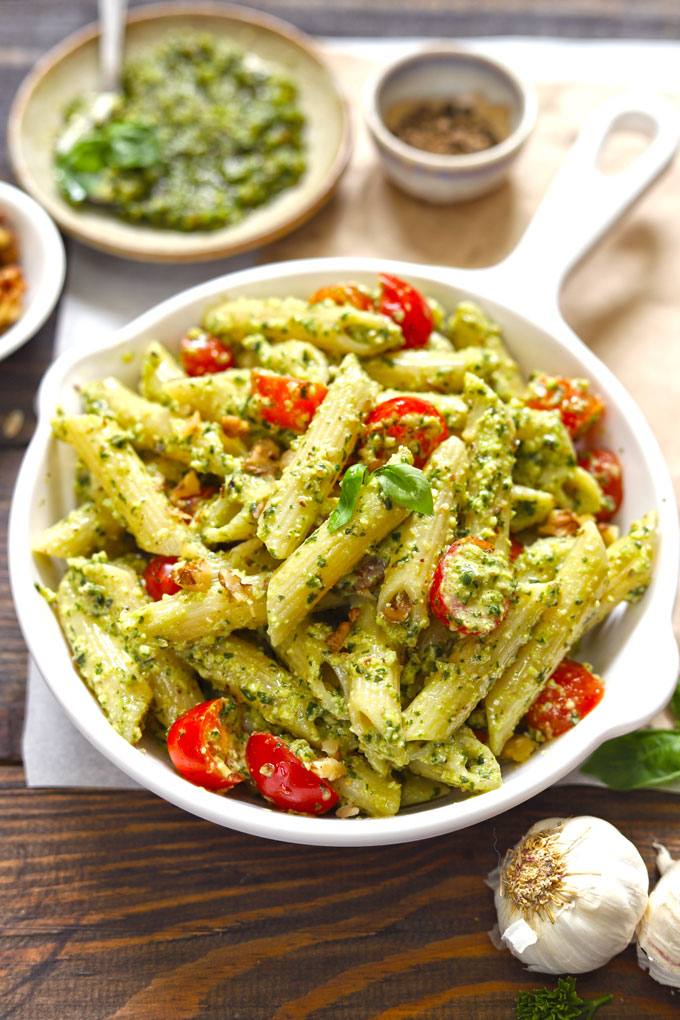
Jump to:
About Basil Walnut Pesto
Pesto or the pesto alla genovese is a traditional Italian sauce made with fresh basil leaves, pine nuts, garlic, salt, Parmesan cheese, and olive oil.
Homemade Pesto Sauce is the best use for all the fresh summer basil growing in your herb garden. It has a coarse, rustic texture, the freshness of basil leaves, and the nuttiness of pine nuts.
I am using a basil and walnut pesto sauce for this pasta recipe. The walnuts give an earthy, robust taste to the pesto sauce.
You can combine broccoli with the basil to make a unique broccoli pesto pasta or almonds and spinach for a vegan pesto sauce.
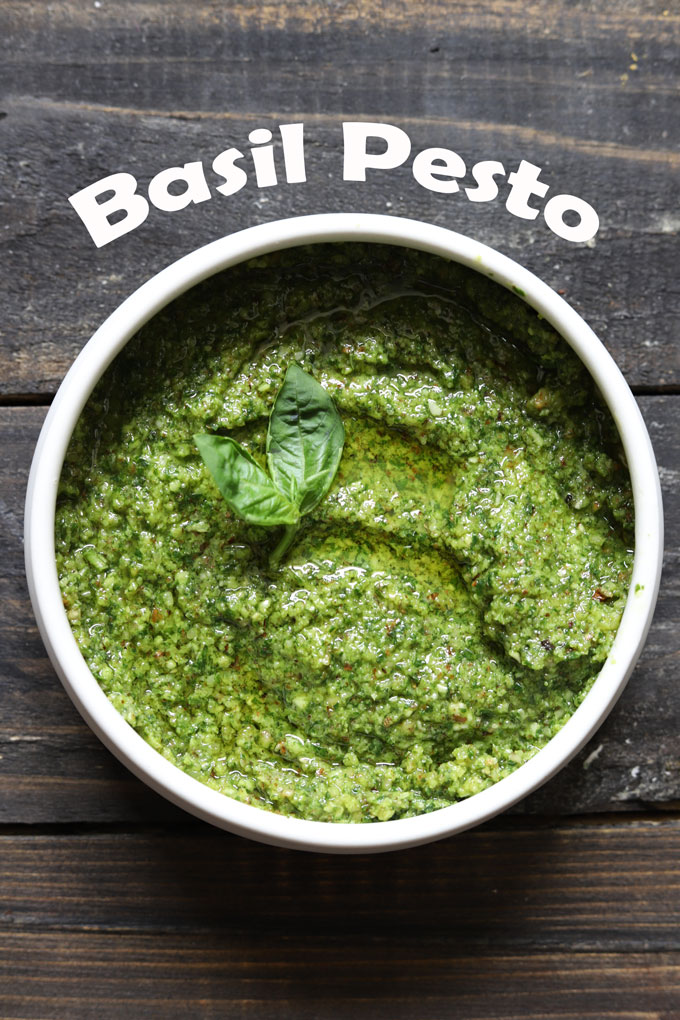
Ingredients You’ll Need For Pesto
You need only 7 ingredients and a food processor to make this pesto sauce. It is a no-cook sauce. Blitz the ingredients and the pesto sauce is ready.
- Fresh Basil: Use only fresh basil leaves for making pesto. Italian Basil will be a perfect choice.
- Walnuts: You can use pine nuts or cashews as well instead of walnuts.
- Cheese: Grated or shredded Parmesan cheese works for this sauce
- Garlic: Adjust the number of garlic cloves according to personal preference
- Olive Oil: Use a good quality extra virgin olive oil
- Salt & Pepper to taste
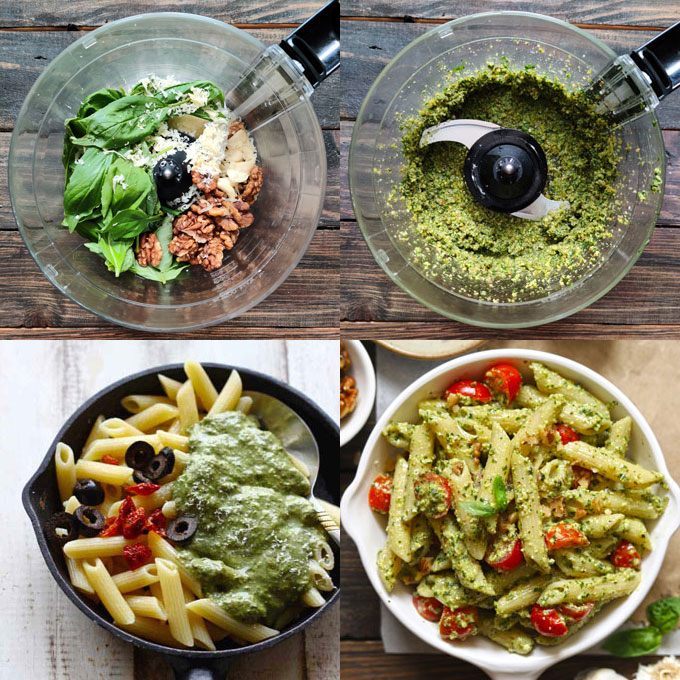
Tips to Avoid Black & Bitter Pesto
Nothing is more satisfying than preparing a batch of pesto sauce at home with handpicked basil leaves from the kitchen garden.
But the biggest challenge with the basil pesto is at times – it turns black and bitter. I am sharing a few tips and tricks to avoid black and bitter pesto sauce:
1) Pesto Sauce is not meant for robust cooking. In fact, the pesto hates the heat. The more you cook the sauce, the more it loses nutrients, freshness, and colour.
My Tip: Combine pesto sauce while the pasta is hot in a mixing bowl and not on the stovetop. Serve immediately.
2) Pesto turns black when exposed to air for a longer duration due to oxidation.
My Tip: This can be prevented by pouring a thin layer of olive oil on top of the pesto and by storing it in an airtight container.
3) Often pesto tastes bitter. Usually, there are two reasons responsible for the same. First, nuts or olive oil has gone rancid. Second, the sauce blended for too long leading to the release of bitter juices of basil leaves.
My Tip: Ensure that you are using quality ingredients and specifically check that the nuts or the olive oil. Second, one or two blitzes in a food processor are enough to make pesto sauce. Or use the traditional mortar and pestle to make the sauce.
Best Pasta For the Pesto Sauce
Feel free to pick pasta of your choice to coat in the green pesto sauce.
- My personal favourites are either spaghetti (long noodle shape) or penne (the tubular shape). The thick and luscious pesto sauce clings nicely to these shapes of pasta.
- I feel the delicate texture of pasta like angel hair also works perfectly to make basil pesto pasta.
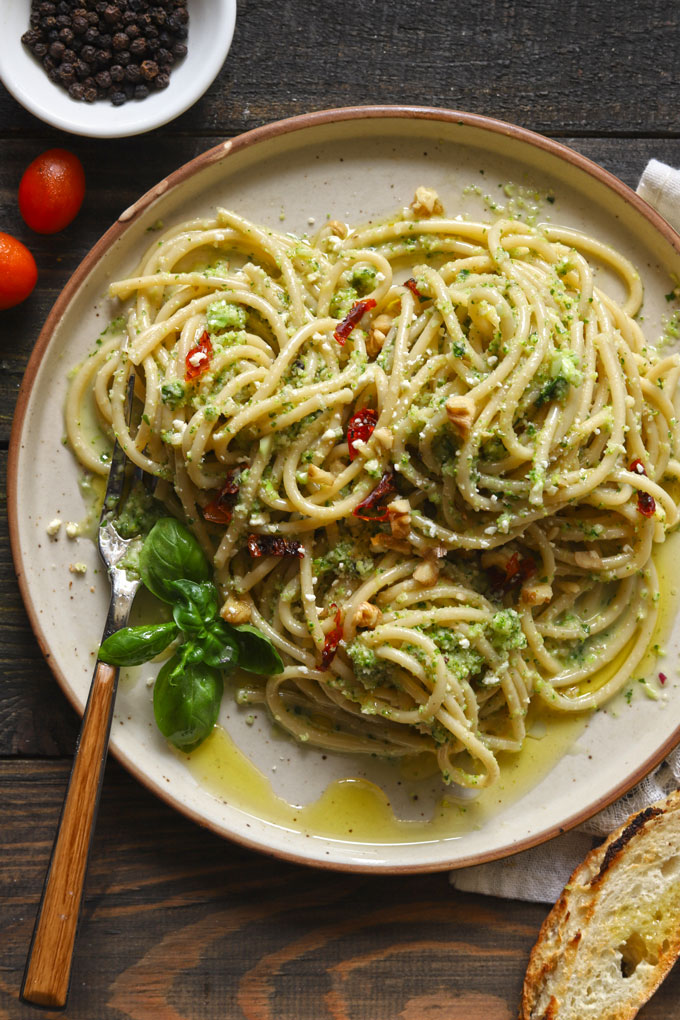
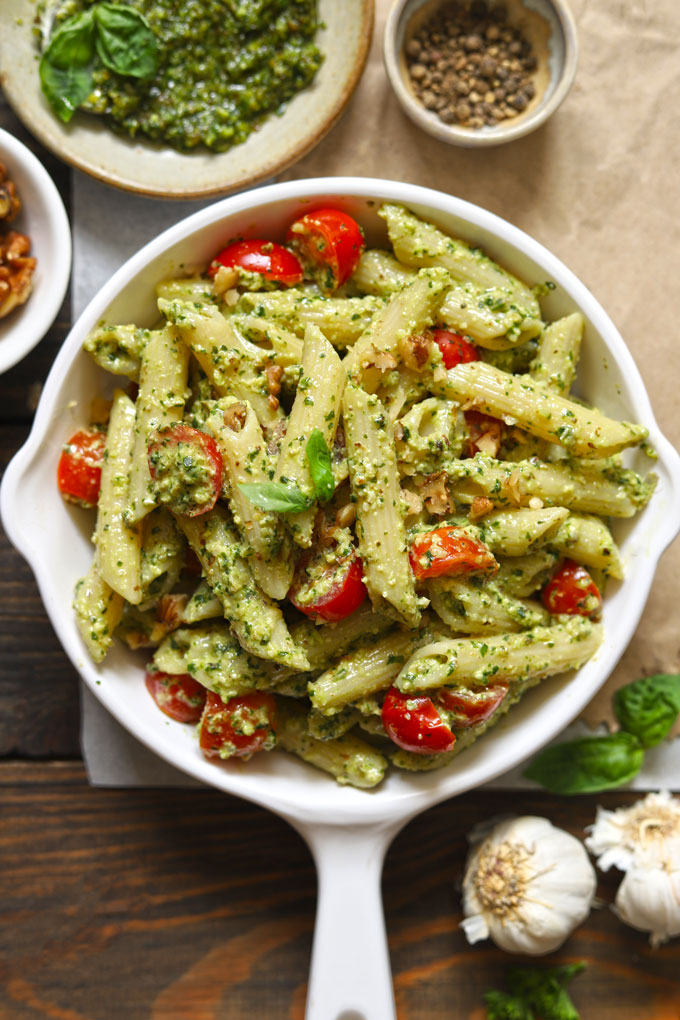
How To Make Basil Pesto Pasta
It is a very simple, straightforward process that requires minimal cooking.
- Cook Pasta: Boil water in a saucepan with salt. Add the desired shape of pasta and cook till al-dente. Reserve 1 cup of boiled pasta water. Drain the remaining water. Transfer the cooked pasta to a mixing bowl
- Make Pesto Sauce: Start with blending the ingredients in a food processor to make the pesto sauce.
- Combine: Add pesto sauce to the cooked pasta. Mix nicely, add ¼ cup of reserved pasta water to make it saucy. Add the remaining ¼ cup of water, cream, cherry tomato, mix, and the basil pesto pasta is ready to serve.
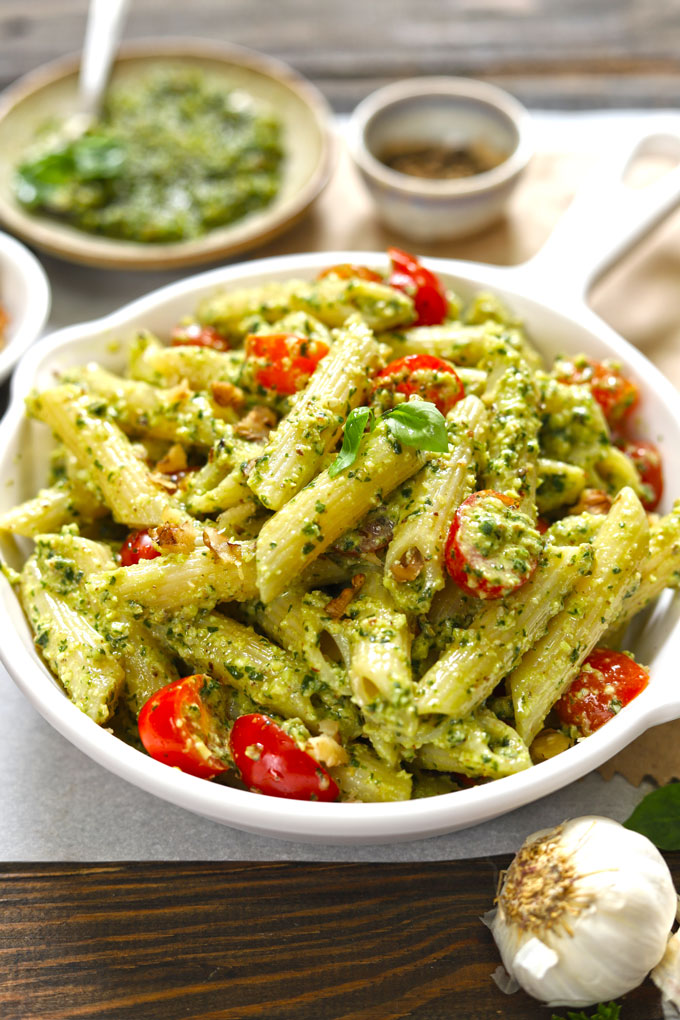
FAQ’s Related To Basil Pesto Pasta
Transfer the pesto to an airtight container, drizzle some olive oil to cover the top, place a cling foil to cover the layer of olive oil. Close the lid of the container and store it in the refrigerator for 2 – 3 days. The colour of the sauce might change after a day or so.
Pesto sauce can be consumed either raw or cooked. It can be used as a dip, salad dressing, or as a gluten-free sandwich spread.
You can re-heat the pesto pasta on a stove-top or microwave. However, this may impact the taste, and colour of the pasta. It will not be as fresh and flavourful. It is best to cook and serve immediately.

More Pasta Recipes
- Tomato Sauce Pasta
- Fusilli Pasta Caprese
- Makhani Sauce Pasta
- Chicken Broccoli Pasta
- Greek Orzo Pasta Salad
- Pasta with Cherry Tomato
- Creamy White Sauce Pasta
- Instant Pot Spaghetti Aglio Olio
follow us on Youtube and Instagram for video recipes.
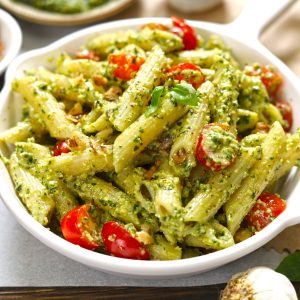
Basil Pesto Pasta Recipe
- Food Processor
- Saucepan
Ingredients
Ingredients For Cooking Pasta:
- 200 gram penne pasta (approx 2 Cups)
- 6 Cup water
- 1 tablespoon salt
Ingredients For Basil Pesto:
- 2 Cup fresh basil leaves
- ½ Cup walnuts
- ¼ Cup grated parmesan cheese
- ¼ Cup extra virgin olive oil
- 4 – 6 garlic cloves
- Salt and pepper to taste
Other Ingredients:
- 1 Cup cherry tomato, cut into halves
- 2 – 4 tablespoon heavy cream (optional)
- 1 tablespoon coarsely chopped walnuts
Instructions
Cook Pasta:
- Boil water in a saucepan with salt. Add the desired shape of pasta and cook till al-dente. Reserve 1 cup of boiled pasta water. Drain the remaining water. Transfer the cooked pasta to a mixing bowl. Set aside.
Make Basil Pesto:
- While the pasta is cooking, start making pesto sauce.
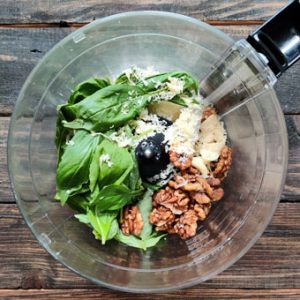
- Add all the pesto ingredients except olive oil in a food processor with the blade attachment. Seal the lid of the food processor. Start blending the ingredients while slowly and steadily pouring the olive oil. You may need to stop. scrape, and again blend the ingredients. But do not blend more than 1 minute.
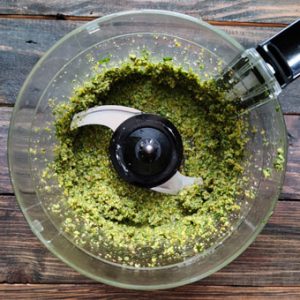
- Store pesto sauce in an airtight conatiner in the refrigerator or use it immediately.
Assemble:
- Transfer cooked pasta to a mixing bowl. Add pesto sauce, cherry tomato, cream, and ¼ cup of reserved boiled pasta water. Toss to evenly coat pasta with the sauce. The sauce should cling to the pasta.
- If the pasta dries up or soak the sauce, add ¼ cup remaining boiled pasta water and toss once again.
- Garnish basil pesto pasta with chopped walnut and cheese.
- Serve Basil Pesto Pasta immediately with focaccia bread.
Recipe Notes:
- Pesto Sauce is not meant for robust cooking. Combine pesto sauce while the pasta is hot in a mixing bowl and not on the stovetop.
- Pesto turns black when exposed to air for a longer duration due to oxidation.
- Do not blend the pesto sauce for too long in the food processor as it might turn bitter.
- Feel free to pick pasta of your choice to coat in the green pesto sauce. My personal favorites are either spaghetti (long noodle shape) or penne (the tubular shape).
- To make the pesto pasta saucy and juicy use the boiled pasta water.
- Adding heavy cream is optional. It makes pesto pasta creamy and rich.

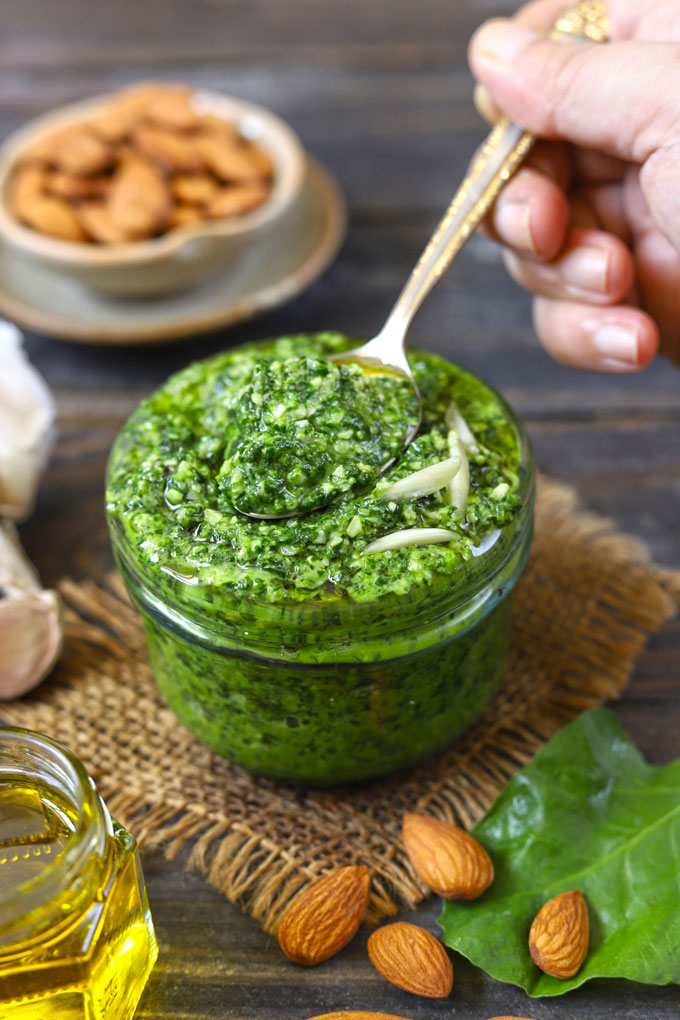
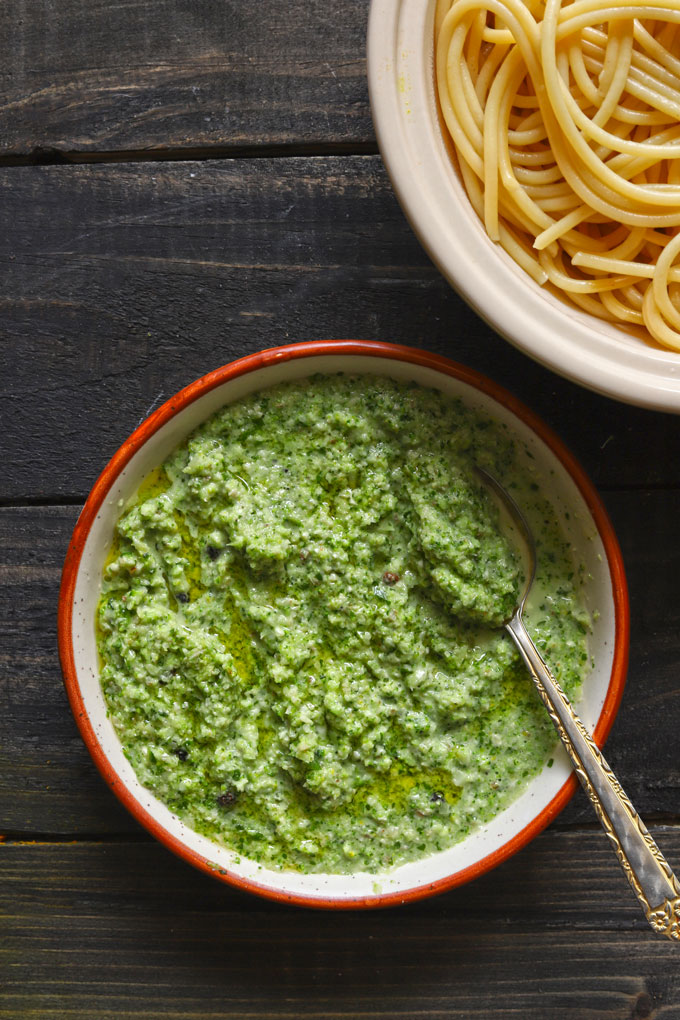
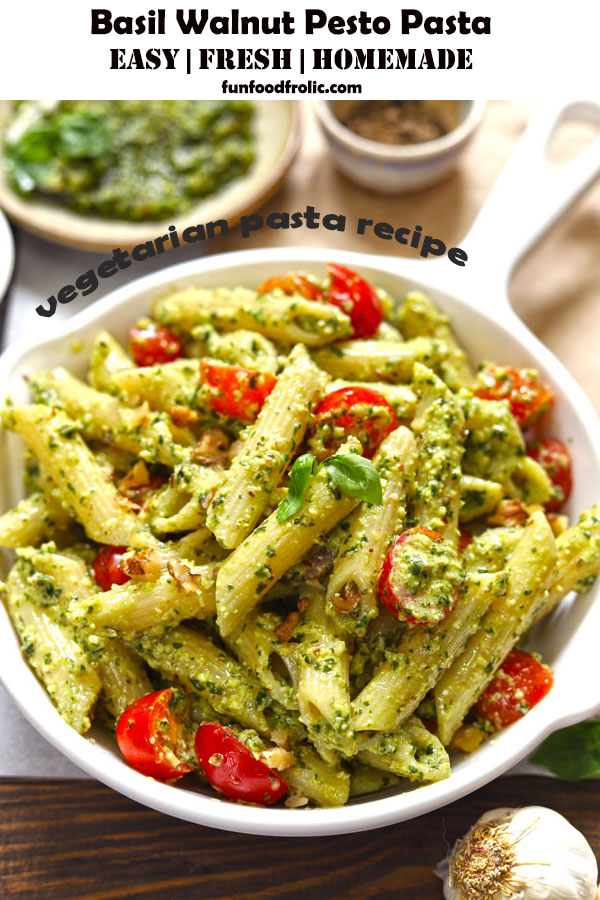
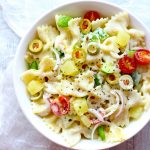

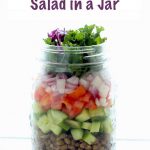
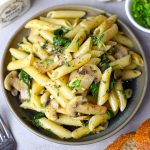
Rajani says
Your pesto pics are as awesome as the recipe. I love fresh pesto for it’s burst of flavour too. This recipe looks so simple yet elegant.
Indrani says
When ever I see your posts my hunger pangs increase many times.
Deepika says
Hi Hina…Can pesto be made in a mixie jar?
Hina Gujral says
Try not to make it very smooth, keep to coarse, and do not grind for too long.
Lynn says
Delicious! Thank you! I added a protein (shrimp) and it was delicious! I also did not have walnuts so I used part cashews and part pine nuts. Thank you for such a great recipe.
Hina Gujral says
So happy to read your feedback!